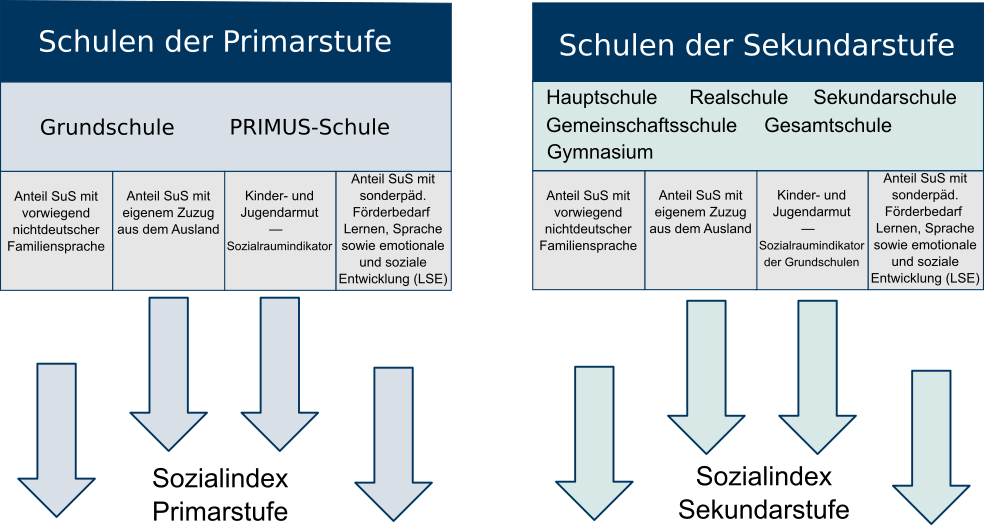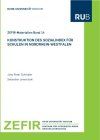FAQ
Frequently Asked Questions regarding the Social Index for Schools
1. On what data foundation is the social index based?
The social index for schools is calculated based on a total of three school-level indicators and one social area indicator:
- Percentage of students with predominantly non-German family language
- Percentage of students with their own immigration from abroad
- Percentage of students with special educational needs in the areas of learning, language, as well as emotional and social development
- Child and youth poverty (social area indicator)
The first three indicators are sourced from school statistics, utilizing school data from the 2018/19 academic year. The indicator for child and youth poverty is a social area indicator based on data from the Federal Employment Agency. It measures the level of SGB II (Unemployment Benefit II/ Social Assistance) rate among minors in the estimated catchment area of the elementary schools. The reference date for this indicator is December 31, 2018.
The index is an aggregate characteristic: it does not reflect individual student performances and characteristics, but solely captures the (socioeconomic) composition of the overall student population at the schools.
2. Why these indicators and not others?
The aim of the index is to capture the social and performance-related composition of a school. The selection of indicators to describe the school situation is guided by the insights from educational research. The results of the PISA studies indicate that "migration-related and social background" is a pivotal dimension concerning performance disparities. Additionally, it is essential that the indicators are consistently accessible for all schools, and the quality of the underlying data, in terms of objectivity and reliability, is guaranteed. The indicators utilized for the social index are obtained from official school statistics and the statistics provided by the Federal Employment Agency, meeting these requirements. The indicators at hand can capture both the social status and migration-related aspects. During the construction of the social index, a thorough examination confirmed that the chosen indicators also describe various starting points for learning. Additionally, concerning the learning assessments VERA 3 and 8, these indicators can explain a substantial portion of the variance in performance disparities.
In addition to the mentioned indicators, another one was included. This indicator takes into account that schools in socially disadvantaged neighborhoods often have to undertake extensive inclusion tasks on top of their regular responsibilities.
As part of the planned updates to the index, an assessment will be conducted to determine the extent to which additional criteria are suitable for the utilization of the social index.
3. How is the Social Index calculated?
Various methods can be used to calculate indices. The values of the indicators are often summed up as a simple approach. However, due to the strong correlation among the selected indicators, we do not use this method for index formation. Instead, we employ a confirmatory factor analysis. This is a recognized methodological approach that has already been used in the construction of location types in North Rhine-Westphalia and is also employed in the construction of other social indices, such as the Hamburg Social Index.

Fig 1: Schema for index construction
A detailed description of the construction of the index can be found here: Schräpler und Jeworutzki (2021): Konstruktion des Sozialindex für Schulen in Nordrhein-Westfalen. Zefir-Materialien Band 14.

4. What weights do the indicators carry in the calculation?
In a confirmatory factor analysis, the index is not derived from a weighted sum of individual indicators, making it impossible to specify weights for the indicators. Instead, within the methodological approach, "factor loadings" are determined, characterizing the relationship between individual indicators and the index. The greater the factor loading, the stronger the correlation of the individual indicator with the index. The indicator "Percentage of students with a non-German family language" exhibits a very strong correlation with the indicator "Child and youth poverty." Along with the indicator "Percentage of students with their own immigration from abroad," these indicators depict the socio-economic conditions at the school level and are summarized by the index.
The indicator "Percentage of students with special educational needs in the areas of learning, language, and emotional and social development" carries more weight in the calculation only when the respective schools also have a higher percentage of child and youth poverty. This is intended to consider and depict a particular dual burden on schools.
5. How do the social index values differ for primary and secondary schools?
The two school indices are based on different school populations. This fact is significant because the index values need to be interpreted in relation to other schools. The social index for the primary level only pertains to primary schools (and PRIMUS schools) and their student composition: a primary school in social index level 9 has a particularly high level of support needs compared to other primary schools. On the other hand, the social index for secondary schools encompasses Hauptschulen (general schools), Realschulen (intermediate schools), Sekundarschulen (secondary schools), Gesamtschulen (comprehensive schools), and Gymnasien (grammar schools), allowing an assessment of support needs in comparison to other secondary schools.
This fact also applies to the location types used so far, which is why they have received different descriptions accordingly.
6. What are the differences between the social index levels and the location types?
The social index and the location types used for the evaluation of VERA 3 and 8 share similar construction principles. However, a direct comparison between location type and social index level is not advisable for several reasons:
- Relevance to Time: The location types were determined based on school data for the school year 2015/2016 and social data as of December 31, 2014. For the social index, school data for the year 2018/19 and social data as of December 31, 2018 were used.
- Utilized Indicators: Both indices utilize the percentage of minors in the school vicinity receiving SGB II (Unemployment Benefit II/ Social Assistance). This is standardized using geostatistical methods and assigned to the primary schools.
However, there is a distinction in the indicators from the school statistics: while the location type only considers the proportion of students with a migration background, the social index takes into account the proportion of students who have immigrated from abroad, the proportion of students with predominantly non-German family language, and the proportion of students with special needs in reading, writing, as well as emotional and social development. - Formation of Tiers: Different methods are employed in creating categories for the social index and the location types (see the subsequent question).
7. How are the social index tiers formed?
The process for computing the social index yields a continuous index value for every individual school. The scale of index values (ranging from 0 to 100) is divided into 9 levels, each with equal intervals. The social index level allows for differentiation of the support needs of the schools: the higher the social index level, the greater the support needs.
The number of schools per social index level varies significantly in some cases. This constitutes a notable difference from the location types, ensuring a fair comparison for VERA 3 and 8: the location types categorize schools into groups 1 to 5, aiming for roughly equivalent school counts in each category. This approach is useful for comparing the VERA results, as it ensures sufficiently large comparison groups for all location types. However, these relatively large categories conceal the differences between the schools within their respective location types. For instance, the standard deviation for location type 5 primary schools is almost twice as large as within the other location types.
For this reason, a different method of tier formation was adopted for the social index.
8. Can the index values of secondary schools be derived from the social index values of the primary schools they originate from?
No, the social indices for the primary level as well as the secondary level are separately calculated, as was the case with the location types.
The calculation is based on the reported school data of each individual school. Therefore, the calculation basis pertains to the actual, available, and reported data regarding the student composition of the secondary school.
Only the social indicator depicting the percentage of impoverished children in the schools is derived from the origin schools for the secondary level. For this purpose, a weighted average value is determined. The transitions from primary schools to secondary schools serve as the weighting factors. To compensate for yearly fluctuations, the transitions from up to five school years are analyzed instead of considering only one cohort.
9. What causes the social index levels of a secondary school to vary from those of the neighboring primary schools?
As previously explained, the index values for primary and secondary schools are calculated independently. Only the social indicator describing the proportion of impoverished children in the schools is derived from the originating primary schools for the secondary level (see Question 8).
Due to a certain level of selectivity associated with the transition to secondary level II, the student proportions relevant for the social index (see Question 1) of a secondary school can vary from those of the nearby primary schools. Furthermore, students at the secondary school may originate not only from the immediate vicinity but also from more remote neighborhoods, especially in the case of comprehensive schools and grammar schools.
10. Why do neighboring primary schools sometimes have different social index values?
Even among neighboring primary schools, the students can vary significantly between the schools. The calculation of the social index value takes into account not only the immediate spatial environment of the primary school but also the values of the other three indicators (see Question 1), which can vary significantly even among nearby schools.